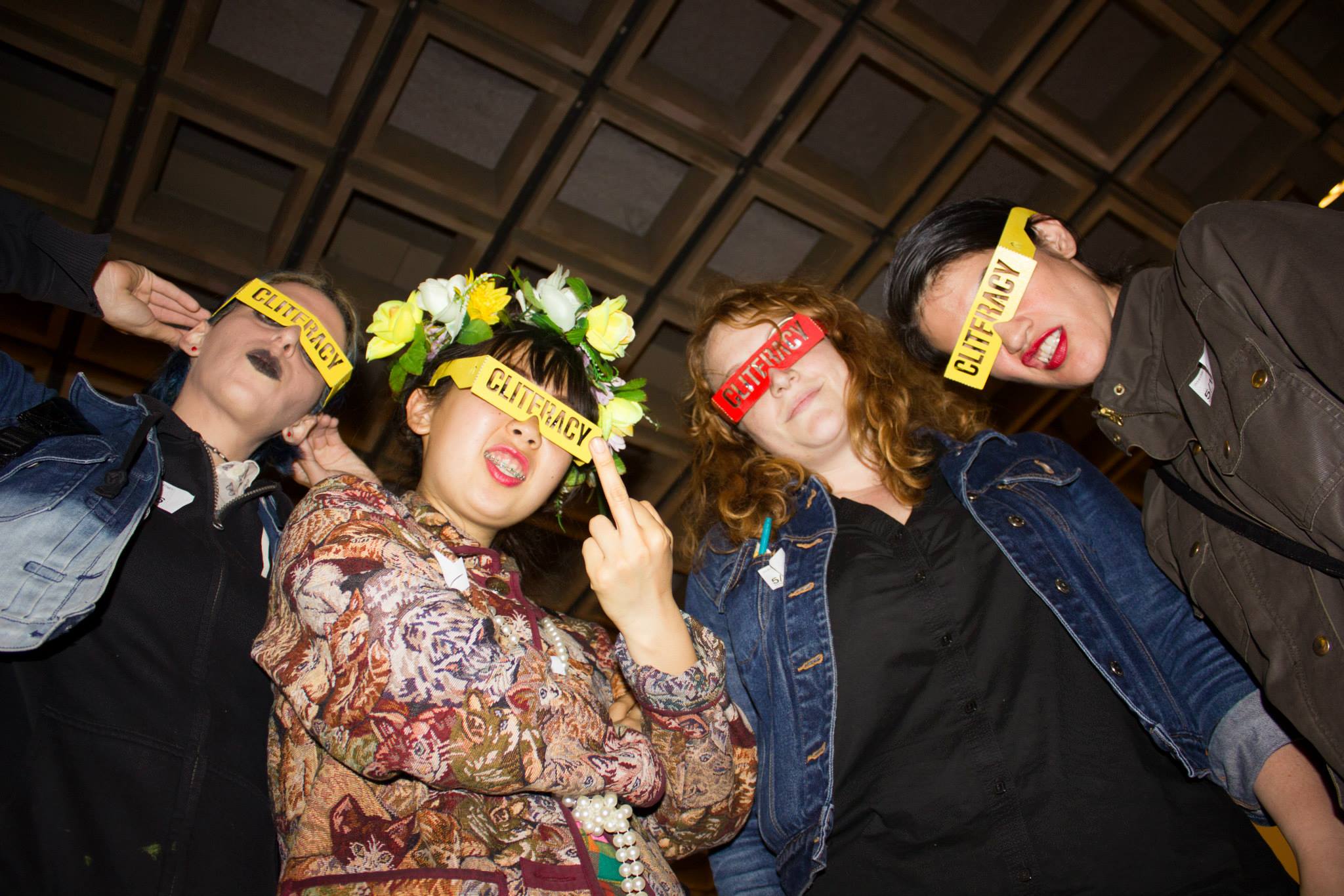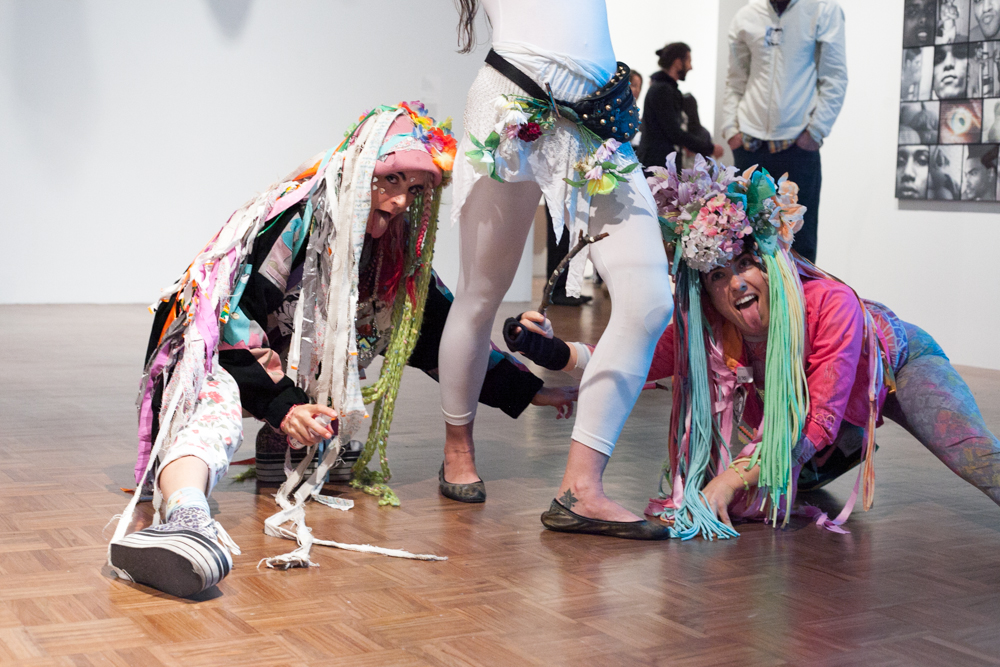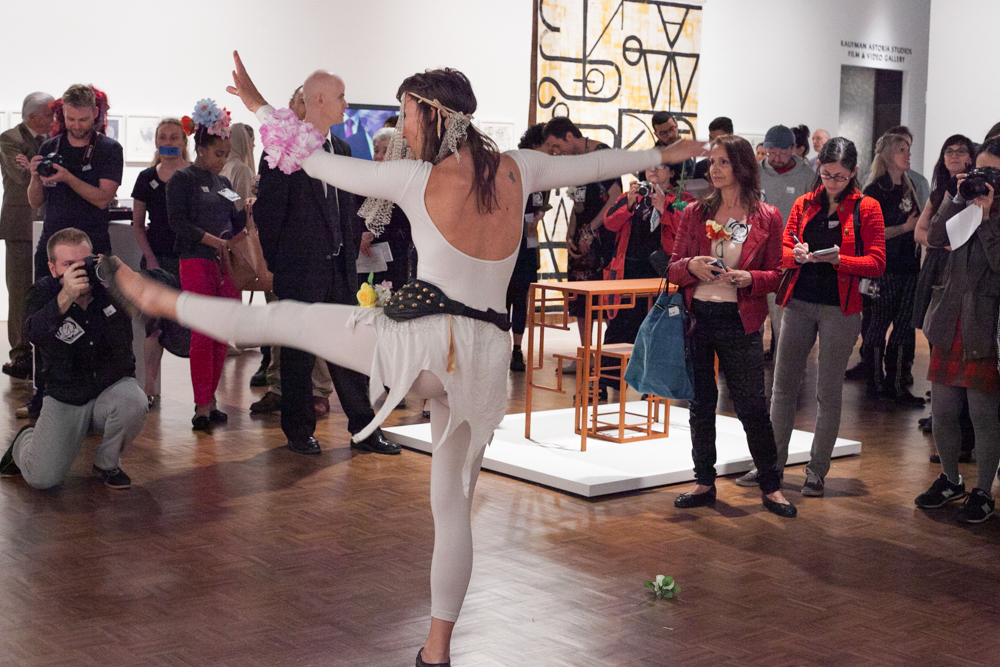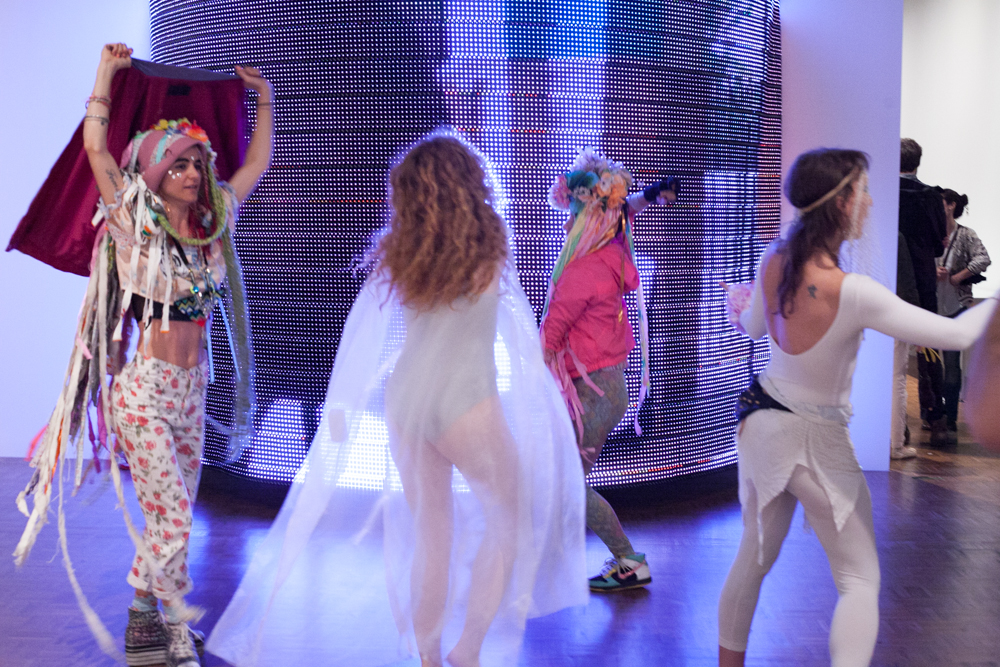Author | Go! Push Pops
We ecstatic dance protested our way into the most important contemporary art exhibition in the country.
Fuck what you heard. We just hijacked a whole floor of the Whitney Museum of American Art. We rolled through a colossal museum’s doors 40 bitches deep with press already lined up to take notes. We passed out vaginal badges with utopian inscription to 600 unsuspecting museum goers, announcing, “Welcome to the Clitney Perennial, thank you for coming to our event.” We connected leagues of feminist collectives throughout NYC into a rhizomatic internet mafia that brought 400 people to convene around intersectional feminist politics (gender, race and class). In many ways the Clitney was like a temporary gift economy. Everyone offered up what they did best and practiced reciprocity and non-hierarchical organization. Meanwhile we ecstatic dance protested our way into the most important contemporary art exhibition in the country. We asserted our agency, claimed a space of our own, and pushed museum goers too look beneath the surface of the museum’s signature exhibition – challenging tokenism and calling for equal representation in the arts based on merit. We made history, together.

The very fact that the blogosphere wants to critique what we wore only further sheds light on the systemic, societal exclusion of women and minorities from the realm of “real work” and “professional excellence.” It assumes that our bodies and physical presentations are not only all that is relevant about us, but always open to public critique and scrutiny. What we perceive in the world is a mirror back unto ourselves. If you came to the Clitney and saw only “flowers and leotards,” then you’re probably a bit too comfortable with women as pretty objects. If you came to the Clitney and saw only porn, you’re probably sex-phobic or sex-obsessed. Historically, vaginal insignia represents the earliest religions of all time, and the power of the Great Goddess. The erasure of an earth-based and gender-egalitarian female symbolic spirituality in favor of patriarchal religion’s Father-Son-Holy Spirit trinity and phallus worship was a type of terrorism to the earth and its people. Our High Priestesses were raped, erased, tortured or turned into domicile brides and wives. Colonial imperialism begins and ends with the control of systems of representation and religion, and today too many of our mind-bodies and their functions remain constructed in relationship to phallocentric symbolic systems. The visual scourge of the Cliteratti was not porn, these are our collective symbols of resistance and transformation.
If you refuse to recognize what we did as Art, you’re probably trapped alone in your studio trying to be a solitary genius in a competition-based paradigm. The Clitney was happening, social practice, protest art, ceremonial pilgrimage, action, coven, coup d’état and sacred vessel of utopian visionary collectivity. Maybe you saw only rainbows and flowers because our auras are 2 footballs fields long each and we bitch slapped you with some heavenly love and light. We are artists, yes, we’re also a bunch of bad bitches, witches, high priestesses, cosmic shape-shifters, change-makers and radical tricksters. We are restoring art to its rightful place at the center of community and symbol of sacred, mindful living.

If we weren’t packing a mean punch of mystical spitfire, why did the museum hire extra security? For the record, said security, mostly huddled around us taking selfies with our Art and thanked us on our way out. One security guard said, “Come back next week, this is the best Friday night I’ve had since I’ve been here.” One guest reported that upon walking into the museum they “overheard one guard say to another, ‘Tonight’s protest should be fun…’” If putting on a show for the mostly black, definitely underpaid staff of the museum isn’t radical and feminist, I don’t know what is. In an economic climate where a terminal degree in the field will maybe get you an internship (if you’re lucky), we need to start rethinking what Art is and whom it’s serving.
I felt nothing but love pouring in from all sides in the days following the Clitney. Emails from 2nd and 3rd wave feminists poured in to say, “Keep Frolicking and Pushing the Female Consciousness Onward!!!!!!!!!!!!!!!” (punctuation original). Kay Turner, former head folklorist of the Brooklyn Arts Council and one of the Clitney leaders remarked, “I have lived the Whitney for more than 30 years, and you completely change my feeling about what it means. Taking ownership even briefly was exhilarating! I skipped down Madison flaunting my Clitney love!” A member of the Yams Collective who was there wrote, “This is a great catalyst. I feel like we are all SWARMING toward an amazing space/place and history! So happy we have connected!”

In the realm of performative protest, our vision was vast. Head organizer Asha Man brought the lunar medicine of the Bushwick Moon Church. Annie Doran, who performed with a handmade “Virginity” doll and animalistic mask, touched on issues of intimacy, femininity and societal gender norms. Visitors had to get down on their knees and lean in real close to hear the audio that went with Annie’s doll – recordings around cleanliness, beauty standards, marriage; the expectation that women should be nice, men should be strong, as well as issues of fear/shame around sexuality and the body. Said Annie, her costume embodied a “fiercer side of femininity,” one that “doesn’t give a shit about societal expectations.” Sophia Wallace’s Cliteracy Project, which invited museum goers to try on paper glasses and experience “Clit Vision” aka “Put a Clit on It” or “ClitDazzle” pushed participants to see beyond the veils of phallocentrism and white male patriarchy gate-keeping the notorious “Whitey Museum.”
Anne Sherwood Pundyk, one of the main organizers of the event, shared some important dialogue that went on in her consciousness raising circles. A professional female art critic revealed she had just learned that her salary was half of that of a male colleague who was her peer. An artist talked about being told on the job as an artist’s assistant the best use of her skills was to keep the studio kitchen clean. As the evening went on, things became more personal says Anne, and the conversation turned toward “identification with our vaginas.” Recalls Anne, “One artist described overhearing a young girl say, while visiting Judy Chicago’s installation of The Dinner Party and The Brooklyn Museum that the three most important parts of her body were her vagina, her voice and her brain, in that order.”

According to Rebecca Goyette, whose full-frontal vagina dentata performance as Octopussy set off a virtual fire-storm of negative commentary on the web the day following the event, her “sex-positive, cross-cultural and queer” performance had the crowds engaging in deep dialogue about sex, vaginas and art. As Rebecca notes, we were much more than “silly white women” in “leotards and flowers” (we also can’t do math apparently) the media made us out to be. Maura McHugh’s work for instance, a piece of blue tape over her mouth with the correct percentage of women in this year’s biennial – 32 % – proves as bunk the authoritarian divide and conquer approach one journalist at Hyperallergic took. Despite being one of the few publications that dared to report on a feminist protest movement in the arts in 2014, their coverage, unfortunately, remained mired in a male-paradigm of critique, ridicule and intellect, which only opened the floodgates for further backlash from readers. As artist Asha Man stated, our protest was largely about “qualitative change.” It was more along the lines of a feminism (as described by philosopher Mary Daly), which asks “nonquestions” about “nondata.”
We were also a much more racially diverse group than the press suggests. In fact, we had spent the night before making plans with some of the Yams Collective, whose decision to pull out of the show earlier that week had added fuel to the flame of our feminist fire. Says Rebecca, “we all were struck by the statistics of artists included in the Biennial. With only 32% women, 9 black artists out of 103 (which included “black woman” Joe Scanlon), we all saw a need for conversation, dissent and creative change.” According to one member of Yams, the museum had not only shut the lights off when their meeting with curator Michelle Grabner had the white female curator totally non-responsive, they had also been officially kicked out of the Whitney when a group of them had gathered to provide some real talk to museum visitors about the politics of white male Yale Professor’s Joe Scanlon’s black female avatar. While a white male posing as a black female to make dick jokes had been given a permanent place in the exhibition, Yams felt their presence as a primarily black female and queer collective had been negated when their video was pushed to the periphery of the exhibition in a temporary “screening” event.

Doing anything as a group defies the logic of the art market and the logic of capitalism and makes you not only brave, but leaders and change-makers. Performance itself, which is hardly compensated, is equally a radical gesture. At the Clitney Perennial, we simply combined forces to come together around a few common denominators we could all agree on. We chose the clit as our symbol to challenge the phallocentric society within which we live. We celebrate the female genitals as a pleasure and power center, and as a symbol of feminist archeomythology, theory and praxis. This is not an essentialist platform, and we recognize that many of us hardly identify with the terms “male” and “female” or “black” and “white” any longer, despite the way in which we might strategically use identity politics to point out real inequalities in the system. For now, we plan to continue worshipping at the altar of our wombs and making art that binds the community and pushes forth into the new paradigm. Keep up and you will be kept up.
